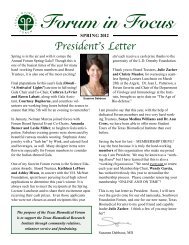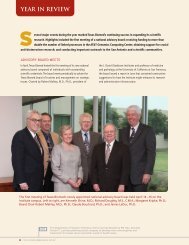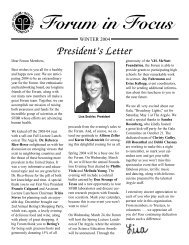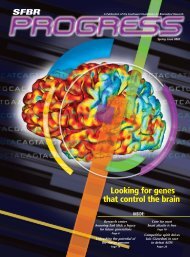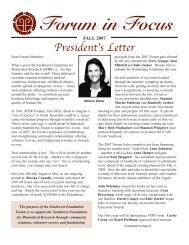Texas Biomed Science Report 2011-2012 - Texas Biomedical ...
Texas Biomed Science Report 2011-2012 - Texas Biomedical ...
Texas Biomed Science Report 2011-2012 - Texas Biomedical ...
Create successful ePaper yourself
Turn your PDF publications into a flip-book with our unique Google optimized e-Paper software.
40<br />
<strong>2011</strong>–<strong>2012</strong> Scientific <strong>Report</strong><br />
“The main goal of the Behavioral Services Program is to provide animals an environment that<br />
encourages the expression of species-typical behaviors, such as social interaction, locomotion,<br />
manipulation, and feeding, in a captive setting.”<br />
Corrine Lutz, Ph.D.<br />
Leader, Behavioral Services, SNPRC<br />
The Behavioral Services program uses accumulated knowledge of the natural<br />
history and behavior of each species housed at SNPRC to develop appropriate<br />
behavioral management and enrichment plans and to promote animal welfare.<br />
The program objectives include providing proper socialization and<br />
environmental enrichment, utilizing positive reinforcement training,<br />
monitoring animal behavior and providing interventions when necessary,<br />
educating the staff, and providing research support.<br />
Providing social contact is the best way to encourage natural behaviors of<br />
nonhuman primates. Almost all of the primates at SNPRC are housed in<br />
pairs or social groups, and Behavioral Services staff members work to ensure<br />
compatibility of the group members. A social partner is perhaps the most<br />
important and basic environmental variable because it provides constantly<br />
changing stimuli and challenges the animal’s social and cognitive<br />
functioning.<br />
Environmental enrichment also includes structural, food, sensory, and<br />
manipulable enrichment. All enclosures are equipped with some form of<br />
structural enrichment such as climbing structures, perches, or swings.<br />
Baboons, chimpanzees, and other monkeys are quite agile and like to rest in<br />
areas above the ground. In addition to the standard nutritional diet, the<br />
primates are provided with food enrichment in the form of a variety of fruits<br />
and vegetables. Additional treats may include yogurt, popcorn, or raisins.<br />
Some foods are placed in foraging devices or puzzles to create added<br />
challenges. A sensory enrichment component includes music, nature videos<br />
and children’s programming on television, and mirrors so animals can view<br />
themselves or their neighbors. The animals also receive a wide variety of toys<br />
and other objects to manipulate. Toys are rotated and replaced to keep the<br />
animals’ interest.<br />
In addition to enrichment, the behavioral team provides a range of<br />
services to support both colony management and research. An animal trainer<br />
Publications<br />
• Lutz CK, Davis EB, Ruggiero AM, Suomi SJ (2007) Early predictors of self-biting in<br />
socially-housed rhesus macaques (Macaca mulatta). Am J Primatol 69:1-7.<br />
• Davenport MD, Lutz CK, Tiefenbacher S, Novak MA, Meyer JS (2008) A rhesus monkey<br />
model of self-injury: effects of relocation stress on behavior and neuroendocrine function.<br />
Biol Psychiat 63:990-996.<br />
• Lutz CK, Meyer JS. Self-injurious behavior: Nonhuman primate models for the human<br />
condition. In: Burbacher TM, Sackett GP, Grant KS, editors. Primate models of children’s<br />
health and developmental disabilities. Salt Lake City (UT): Academic Press; 2008, p. 109-40.<br />
• Iredale SK, Nevill CH, Lutz CK (2010) The influence of observer presence on baboon (Papio<br />
spp.) and rhesus macaque (Macaca mulatta) behavior. Appl An Behav Sci 122:53-77.<br />
• Lutz CK, Coleman K, Maier A, McCowan B (<strong>2011</strong>) Abnormal behavior in rhesus monkeys: risk<br />
factors within and between animals and facilities. Am J Primatol 73 (Suppl. 1):41.<br />
works with care staff and technicians to train animals for routine<br />
husbandry and clinical procedures such as shifting cages and presenting<br />
body parts for inspection or injection. Training provides positive human<br />
interaction, reduces stress on animals, and makes staff responsibilities<br />
easier. The Behavioral Services staff conducts routine observations on many<br />
of the animals to assess their well-being. In situations in which the animals<br />
may need extra attention, a behavioral intervention plan is instituted.<br />
Interventions may include additional or different enrichment or movement<br />
to a new social group. Assessments and interventions help us to provide<br />
individuals with optimal housing and social settings.<br />
Behavioral Services personnel consult with investigators whose projects<br />
may be affected by the behavioral abilities, needs, and limitations of study<br />
animals. In addition, they often make recommendations regarding which<br />
animals to use for a given project and develop procedures for collecting<br />
behavioral data. To further educate the staff, Behavioral Services teaches<br />
classes that cover the natural history and behavior of nonhuman primates,<br />
animal training, and environmental enrichment.<br />
E For more information, please visit www.txbiomed.org/primate-researchcenter/primate-research-center-staff-bio?u=138<br />
Staff<br />
Left to right: Maribel Vazquez, Kim<br />
Linsenbardt, Blake Harrington, Corrine<br />
Lutz, Heath Nevill, Sabrina Bourgeois


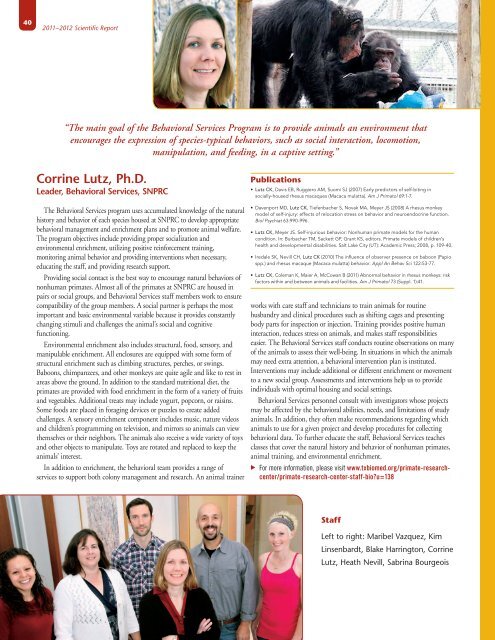

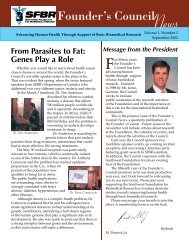
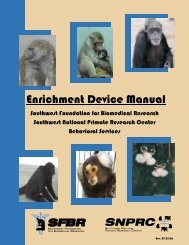
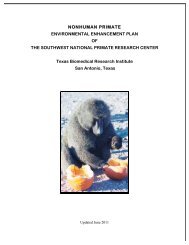
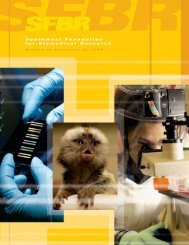

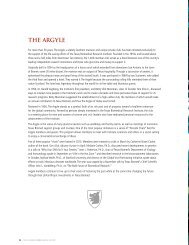
![Vol. 8 No. 2, 2011 [PDF] - Texas Biomedical Research Institute](https://img.yumpu.com/35688099/1/190x245/vol-8-no-2-2011-pdf-texas-biomedical-research-institute.jpg?quality=85)
